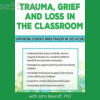Trauma, Grief and Loss in the Classroom: Supporting Students When Tragedy of Loss Occurs By John Bearoff – PESI
$249.00 Original price was: $249.00.$23.10Current price is: $23.10.
Trauma, Grief and Loss in the Classroom: Supporting Students When Tragedy or Loss Occurs – Digital Download!

Trauma, Grief and Loss in the Classroom: Supporting Students When Tragedy of Loss Occurs By John Bearoff – PESI
Overview

Trauma, Grief, and Loss in the Classroom: Supporting Students When Tragedy or Loss Occurs
The experience of loss is an inherent part of the human condition, one that resonates deeply within educational environments. Educators frequently face the emotional and psychological challenges that arise when students experience trauma, grief, or loss. John Bearoff’s course, Trauma, Grief, and Loss in the Classroom: Supporting Students When Tragedy or Loss Occurs, offers valuable guidance for teachers, counselors, and school staff, equipping them with essential strategies to help students cope with these painful experiences. This review will explore the insights provided in Bearoff’s course, emphasizing the importance of understanding grief reactions and the proactive steps educators can take to support students and promote resilience.
Understanding How Loss Affects Students’ Emotional Well-Being
Loss can take many forms, such as the death of a loved one, divorce, illness, natural disasters, or community violence. Each of these experiences can trigger intense emotional turmoil, which manifests differently in the classroom. Research indicates that the effects of loss vary greatly among students, often resulting in declines in academic performance, behavioral shifts, and social withdrawal. These effects extend beyond the individual, influencing the classroom as a whole.
In Bearoff’s course, participants learn about the various stages of grief and how they manifest in students across different developmental stages. Understanding these stages is crucial, as grief responses differ significantly between children, adolescents, and teenagers. For example, younger children may express grief through tantrums or regressive behavior, while older students may cope by withdrawing or showing heightened anxiety. Acknowledging these differences helps educators tailor their approach to better meet the unique needs of their students.
To provide effective support to grieving students, educators must distinguish between normal and pathological grief responses. Bearoff highlights that while grief is a personal journey, there are warning signs when a student’s grief becomes concerning and requires additional intervention. For example, prolonged sadness, a significant drop in academic performance, or social isolation may indicate a need for further support. This knowledge helps educators recognize when to step in and provide assistance.
Debunking Common Grief Misconceptions
A challenge in handling grief in educational settings lies in the misconceptions surrounding the grieving process. Many people mistakenly believe that grief follows a linear path with a clear end point. However, Bearoff explains that grief is more like a winding journey, where individuals may cycle through various stages repeatedly. Educators need to help students understand that their grief may fluctuate and resurface unexpectedly, even after significant time has passed since the loss.
Furthermore, dispelling these misconceptions can promote a deeper understanding of grief within the entire school community. This shift in perception fosters empathy among staff and students, creating a supportive atmosphere. When everyone recognizes that grief is a unique and personal experience, the stigma often associated with expressing grief diminishes, allowing students to feel safer sharing their feelings and experiences.
Targeted Approaches and Techniques for Supporting Grieving Students
Bearoff’s course offers specific interventions and strategies designed to support grieving students, taking into account their age and the nature of their grief. These strategies help create an empathetic classroom environment that encourages healing. The interventions are flexible, addressing both individual and group needs.
For example, one-on-one support may involve simply listening to a student, providing a safe space for them to express their emotions. On a larger scale, classroom strategies might include activities that encourage peer support for grieving classmates, such as group discussions or exercises designed to foster empathy. These initiatives not only comfort grieving students but also help their peers develop greater emotional understanding.
Here is a table of some examples of these interventions:
| Intervention Type | Description |
|---|---|
| One-on-one support | Personalized interaction focused on listening and emotional validation. |
| Classroom discussions | Providing opportunities for students to share their feelings in a group setting. |
| Empathy exercises | Activities designed to help students better understand the emotions of their peers. |
| Creative outlets | Encouraging students to express their grief through art, music, or writing. |
These interventions enable educators to cultivate a trauma-sensitive classroom that fosters resilience and promotes a collective understanding of trauma’s impact on the school community.
Educators’ Role in Providing Emotional Support
Bearoff stresses that educators not only support grieving students but also must care for their own emotional well-being. Teachers often shoulder the emotional weight of their students’ grief, making it essential for them to engage in self-care practices and seek support when necessary. The course emphasizes the importance of developing postvention plans that support both students and staff in the aftermath of a tragedy.
Educators are encouraged to create proactive support systems that address the immediate and long-term needs of grieving students. This can include collaborating with school psychologists, counselors, and community resources to ensure that everyone involved is equipped to handle grief-related challenges effectively.
Bearoff’s background as a licensed clinical social worker and school psychologist informs his approach, emphasizing the need for supportive systems in schools. His model encourages educational staff to prioritize emotional well-being, recognizing that it is closely tied to academic success. By fostering an understanding, compassionate environment, educators can create a space where both healing and learning coexist.
Creating a Classroom Culture of Empathy and Resilience
Creating a trauma-sensitive classroom involves more than just implementing support strategies; it requires cultivating a culture of understanding, compassion, and resilience. Bearoff’s course explores how educators can integrate various principles to develop an inclusive and empathetic environment that acknowledges the complex nature of grief and trauma. This involves ongoing education about trauma-informed practices and a commitment to creating a safe space for all students.
One effective approach for establishing a trauma-sensitive classroom is integrating social-emotional learning (SEL) into the curriculum. SEL helps students develop essential skills for managing their emotions, understanding the emotions of others, and coping with challenges in healthy ways. These programs not only support grieving students but also enhance the overall well-being and social cohesion of the classroom.
Additionally, educators can foster open communication about grief, allowing students to share their thoughts and feelings freely without fear of judgment. This openness creates an atmosphere of trust, enabling students to process their grief together and feel supported by their peers.
Conclusion
Addressing trauma, grief, and loss in the classroom is a profound challenge that requires a thoughtful and multifaceted approach. John Bearoff’s course, Trauma, Grief, and Loss in the Classroom: Supporting Students When Tragedy or Loss Occurs, equips educators with the insights, strategies, and support systems needed to navigate these difficulties effectively. By understanding the impact of grief on students, debunking misconceptions, and adopting specific interventions, educators can foster a resilient and empathetic classroom environment. Proactive support and trauma-sensitive practices not only help grieving students but also contribute to a collective understanding of the power of empathy in education. This journey towards healing and resilience is essential, and the tools provided in Bearoff’s course serve as invaluable resources in this ongoing process.
Frequently Asked Questions:
Business Model Innovation: We operate a group buying strategy, allowing participants to share costs and access popular courses at reduced prices. This model benefits individuals with limited financial resources, despite concerns from content creators about distribution methods.
Legal Considerations: The legality of our operations involves complex issues. Although we don’t have explicit permission from course creators to resell their content, there are no specific resale restrictions stated at the time of purchase. This ambiguity creates an opportunity for us to provide affordable educational resources.
Quality Control: We ensure that all course materials purchased are identical to those offered directly by the creators. However, it’s important to understand that we are not official providers. As such, our offerings do not include:
– Live coaching calls or sessions with the course author.
– Access to exclusive author-controlled groups or portals.
– Membership in private forums.
– Direct email support from the author or their team.
We aim to reduce the cost barrier in education by offering these courses independently, without the premium services available through official channels. We appreciate your understanding of our unique approach.
Be the first to review “Trauma, Grief and Loss in the Classroom: Supporting Students When Tragedy of Loss Occurs By John Bearoff – PESI” Cancel reply
You must be logged in to post a review.

 Trauma-Informed Yoga for Children and Adolescents: Mind-Body Sequencing for ADHD, Anxiety and Post-Traumatic Stress By Kathy Flaminio
Trauma-Informed Yoga for Children and Adolescents: Mind-Body Sequencing for ADHD, Anxiety and Post-Traumatic Stress By Kathy Flaminio 















Reviews
There are no reviews yet.